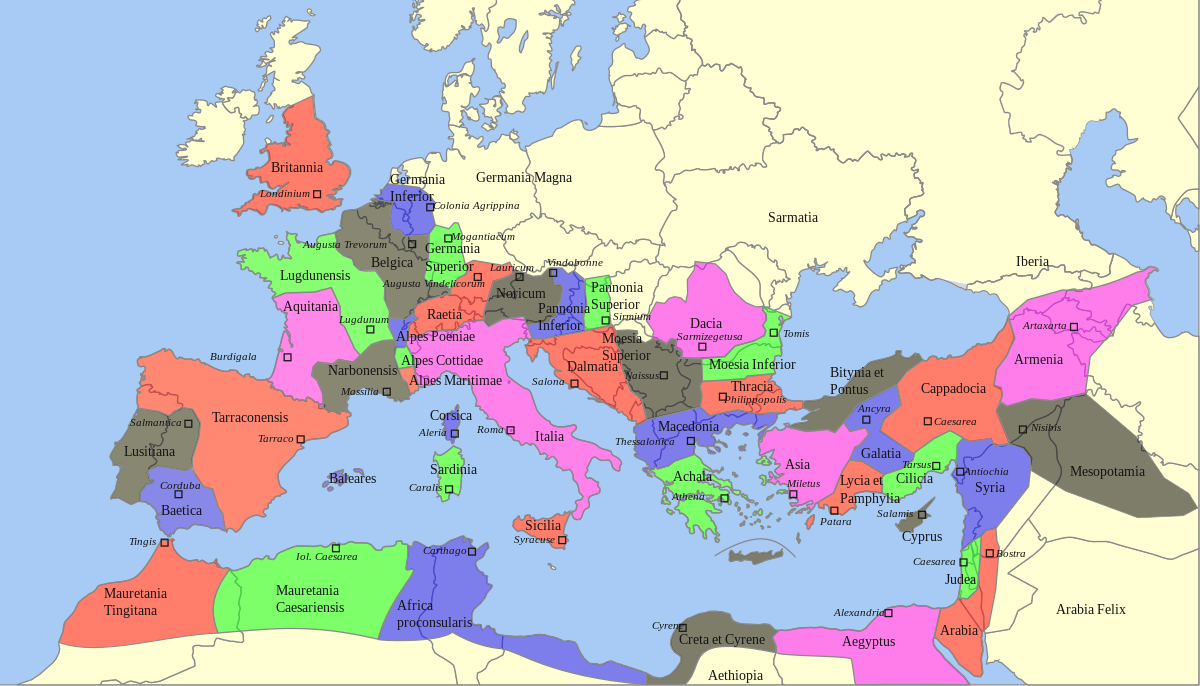Many of today's grape varieties probably carry genetic material from old vines that were already cultivated in antiquity by the Greeks, Romans and Phoenicians. However, most of the grapevine varieties still in existence today probably only emerged in the Middle Ages or later centuries from the varieties that existed at that time. Most of the ancient grape varieties had a blue or black berry colour. The red, yellow and green varieties arose later through mutation and were maintained as independent colour varieties through vegetative propagation. Pinot Blanc, Pinot Gris and Pinot Meunier, for example, were created by bud mutations on Pinot. Which varieties were actually cultivated by the Romans can only be guessed at today, because there are only Latin names and rough descriptions of the Roman varieties. The map shows the Roman Empire at the time of its greatest expansion at the end of the reign of Emperor Hadrian (53-117).

Vine varieties in ancient Rome
However, the variety names used by the Romans were already out of use during the Middle Ages. Thus, 2000 years later, no clear linguistic bridges to grape varieties still existing today can be established on the basis of handed-down names alone. Molecular genetics or DNA analyses would only be able to help here if fossil grape variety remains from Roman excavations could be directly compared with the DNA of varieties still present today. However, this has not been attempted so far. Thus, one has to rely entirely on the rough descriptions which, based on certain characteristics of the vine with regard to morphology(flowers, shoots, grapes, leaves), susceptibility to disease, vegetation cycle and wineigenic species, allow one to assume a relationship to today's varieties only very vaguely at best.
The basis for this are the descriptions of Roman viticulture by contemporary witnesses. Historical reporters such as Strabo (63 B.C. to A.D. 28), Columella (1st century) and Pliny the Elder (23-79) mentioned the most important grape varieties of their time in their works and described, in some cases in detail, cultivation methods, fertility (yields) and the quality of the ancient wines pressed from them. Among them were the varieties Allobrogica, Aminea, Arcelaca (also Argitis), Biturica (also Balisca or Cocolubis), Nomentana and Rhetica (variety for the famous Raeticum). Pliny also mentions a local grape variety Holconia, which was named in Pompeii after one of the most famous families there. From Sicily, Murgentina was introduced to Pompeii by the Greeks long before Christ, and it developed very well on the volcanic soil of the slopes of Vesuvius. Pliny proposed varietal cultivation in order to better assess the varieties.
Descendants of the ancient grape varieties
Lambrusco, which is now widespread in Emilia-Romagna, with its numerous varieties, can also be counted among them, for this variety (or ancestor) was already mentioned by Cato the Elder (234-149 BC). In general, we can assume that in the warm, Mediterranean cultivation zones, varieties exist to this day whose ancestors were already cultivated by the Greeks, Romans and Phoenicians and at least passed on their genes. These could be Aglianico, César, Chasselas, Coda di Volpe Bianca, Falanghina, Fiano, Greco, Greco Bianco, Korinthiaki and Lambrusca di Alessandria (see also under César). Presumably, the ancient advanced civilisations were also already engaged in breeding (crossing) new varieties.

However, there is no clear and scientifically recognisable evidence. What may be true for the southern cultivation zones is certainly not true for the northern continental cultivation zones. For one must be aware that the heat-requiring and late-maturing Mediterranean varieties have not necessarily been successful there. Therefore, it is assumed that in the regions more threatened by winter frost, cross-breeding with local wild vines took place to ensure a shorter ripening phase and higher frost hardiness. Since the Celts (Gauls) also practised viticulture, it is assumed that old varieties such as Pinot and Traminer were already cultivated in Roman times. The great age and the wide distribution would then explain why many regional mutations or clone variants of these varieties could develop.
Some seemingly plausible assumptions have had to be revoked in the meantime due to genetic relationship analyses. For example, the Roman vine Vitis albuelis (Vitis alba) mentioned by the two authors already mentioned, Columella and Pliny, is most likely not to be equated with the white Elbling, because this certainly did not develop until the late Middle Ages as a child of the White Heunisch (Gouais Blanc). This also applies to well over a hundred other grape varieties such as Aligoté, Blaufränkisch, Chardonnay, Gamay, Knipperlé and Riesling with Heunisch/Gouais Blanc as a parent. See also under Ancient Wines, Grapevine Systematics and a list of grapevine-related keywords under Grapevine.
Grape varieties: M.I.P.A.F - National Vine Certification Service
Map: Derived from Sebastian Wallroth: Roman Provinces and Map of Europe, CC BY-SA 3.0, Link
Voices of our members

Using the encyclopaedia is not only time-saving, but also extremely convenient. What's more, the information is always up to date.
Markus J. Eser
Weinakademiker und Herausgeber „Der Weinkalender“